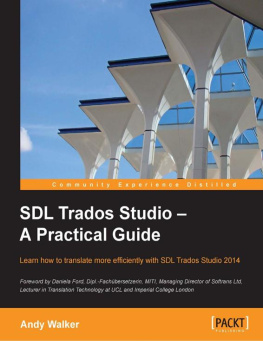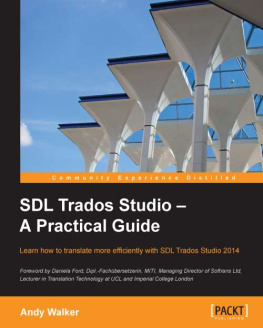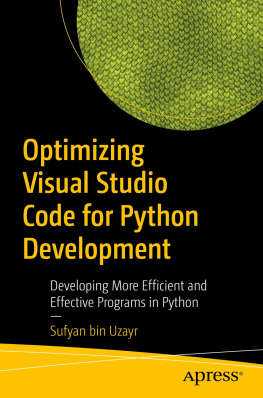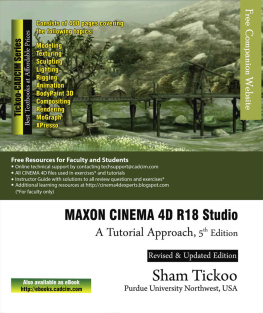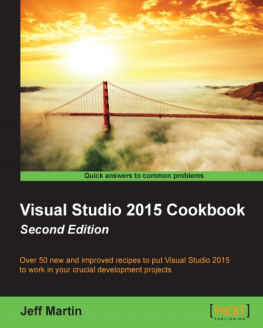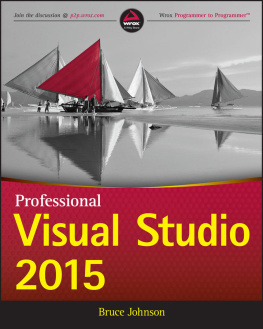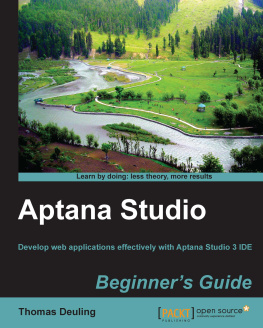Andy Walker - SDL Trados Studio : a pratical guide : learn how to translate more efficiently with SDL Trados Studio 2014
Here you can read online Andy Walker - SDL Trados Studio : a pratical guide : learn how to translate more efficiently with SDL Trados Studio 2014 full text of the book (entire story) in english for free. Download pdf and epub, get meaning, cover and reviews about this ebook. City: Birmingham, UK, year: 2014, publisher: Packt Publishing, genre: Home and family. Description of the work, (preface) as well as reviews are available. Best literature library LitArk.com created for fans of good reading and offers a wide selection of genres:
Romance novel
Science fiction
Adventure
Detective
Science
History
Home and family
Prose
Art
Politics
Computer
Non-fiction
Religion
Business
Children
Humor
Choose a favorite category and find really read worthwhile books. Enjoy immersion in the world of imagination, feel the emotions of the characters or learn something new for yourself, make an fascinating discovery.
- Book:SDL Trados Studio : a pratical guide : learn how to translate more efficiently with SDL Trados Studio 2014
- Author:
- Publisher:Packt Publishing
- Genre:
- Year:2014
- City:Birmingham, UK
- Rating:5 / 5
- Favourites:Add to favourites
- Your mark:
SDL Trados Studio : a pratical guide : learn how to translate more efficiently with SDL Trados Studio 2014: summary, description and annotation
We offer to read an annotation, description, summary or preface (depends on what the author of the book "SDL Trados Studio : a pratical guide : learn how to translate more efficiently with SDL Trados Studio 2014" wrote himself). If you haven't found the necessary information about the book — write in the comments, we will try to find it.
- Unleash the power of Tradoss many features to boost your translation efficiency
- Get up to date with the new version of Trados Studio 2014
- Master a wide range of important tasks from translating, formatting, reviewing and editing, to managing terminology and upgrading translation memories
This book is designed both for new users and those who already have some knowledge of SDL Trados Studio. Its aim is to acquaint you with the key features of the program quickly and to help you enhance your knowledge through more in-depth exploration. No previous experience of translation memory programs is required, although it is assumed that readers will be comfortable working with standard MS Windows applications.
What You Will Learn- Navigate and customize the new SDL Trados Studio 2014 interface
- Create translation memories and use them to make your work more efficient
- Understand how tags work to preserve the formatting and functionality of your document
- Produce word counts for quoting and billing
- Harness the power of SDL Trados Studio for reviewing, editing, and checking
- Work with projects to store translation settings and translate groups of files
- Manage terminology to get automatic matches without having to look things up
- Align previously translated material into a translation memory
SDL Trados Studio has a huge range of features that can be bewildering to the new user. Once properly understood, though, it can quickly become an indispensible part of the translators toolkit, helping to make the process of translating, reviewing, and managing documents a great deal more efficient.
SDL Trados Studio: A Practical Guide aims to help you to get to grips with the power of SDL Trados Studio 2014 quickly and painlessly. This book addresses the practical issues that you encounter in your day to day work in the world of translation. It will help you with everything right from installation, creating translation memories to the final translations and managing translation memories.
The book is based on the latest, 2014 version of SDL Trados Studio. You will learn how to make the best use of SDL Trados Studio during each phase of the translation process, from creating translation memories, through translation, review, and billing for work. The book also covers a number of other features to help make your work more efficient, such as managing terminology, using projects to store translation settings and translate groups of files together, and managing and maintaining the material in translation memories.
Andy Walker: author's other books
Who wrote SDL Trados Studio : a pratical guide : learn how to translate more efficiently with SDL Trados Studio 2014? Find out the surname, the name of the author of the book and a list of all author's works by series.

